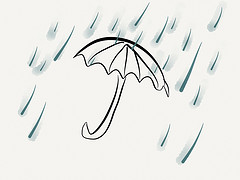 |
You may or may not have heard that it’s wise to have an emergency fund. Even if you’ve heard it, you may not be aware of what it means and why you should have one – and more importantly why you need one. An emergency fund is just that. It’s money set aside for a rainy day, an unexpected bump in the road, or for a real emergency or an expense that you haven’t specifically planned for. Examples of those unexpected expenses (borderline redundant – I know) include a car accident, disability, storm damage to your home, losing a job, being a victim of theft, etc.
So what makes up an emergency fund? Generally, a good place to start is to have a goal of at least 3 to 6 months of non-discretionary living expenses put away in a relatively liquid account such as a savings, checking or money market account. Non-discretionary living expenses are those that do not go away, should you lose your job or the ability to generate income. These expenses would include your mortgage payment, rent, utilities, food, car payment and taxes.
Now comes the easy part.
Simply add up all of your non-discretionary living expenses that you have in a month and multiply by 3 and then multiply by 6. This is the amount you’d need to have set aside. For example, if I have a $1,200 mortgage, $400 in groceries per month, and utilities of $300, I would have a total of $1,900 monthly in expenses. Multiply that number by 3 ($5,700) and again by 6 ($11,400) and it looks like I’d need between $5,700 and $11,400 set aside for my emergency fund.
These amounts are not set in stone. The amount you’ll need will also depend on your job, your income, and how you’re paid. If I’m a tenured college professor making $6,000 monthly, I may only need 3 to 6 months put away. If I’m an executive or CEO of a large company and I make $20,000 monthly, or I’m a commissioned sales person making $10,000 monthly, I may consider having a fund of 9 to 12 months. This would be because there’s a good chance of me not being able to find another job at that income level if I were fired or laid off. And generally, as peoples’ incomes increase, so do their expenses.
Now comes that hard part – actually saving the money.
It’s really not that hard, it just takes a bit of planning and discipline you’ll be well on your way. You can start by putting away a small sum every week or month – depending on what works for you. This could be $50, $100, or even $500 per month until you’ve funded account. If you’re looking for places to find money consider cutting unnecessary expenses until you’ve got your emergency fund at 100%. Reduce your phone bill, cut your cable TV costs, and pack your lunch instead of dining out. Notice a pattern? These are all discretionary expenses – those that can go away if you want them to.
Your emergency fund can also be used in tandem with your insurance deductibles. Let’s say you have low deductibles on your auto insurance and want to save some money. You can simply increase your deductibles and should you need to use your deductible for a claim, you can take from your emergency fund. This is wise especially if you rarely file claims. If you have a disability policy with a 60 day elimination period (time deductible) before benefits start, you can use your emergency fund to help cover the expenses for those 60 days until your benefits begin.
Now that you know what an emergency fund is, it’s important to know what it’s not. It is not a slush fund to buy toys like a new car, boat, TV, etc. It’s not money to play with, gamble with or dip into because “It’s only a couple bucks, it can’t hurt anything.” Those couple of bucks can add up to thousands in no time. Don’t steal from yourself. Resist the temptation to spend it. If you feel you may be the type of person to be tempted, consider putting the money in an account that’s not easy to get to – such as a money market account outside of your city or state. You may also consider having check writing privileges but only on amounts above a certain amount like $250. This can help resist the urge to spend on little things help put a time buffer on when you think you want the money, and when you can actually get it.
One final note is to make sure your emergency fund is not your 401(k), 403(b), traditional or Roth IRA. These are retirement accounts and should stay as such. A properly funded emergency fund will reduce if not eliminate any reliance on premature retirement account distributions.
Now, sit back, relax, and pray you don’t need to use it!